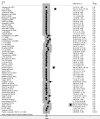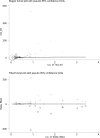Tumor necrosis factor alpha is a promising circulating biomarker for the development of obstructive sleep apnea syndrome: a meta-analysis
- PMID: 28187003
- PMCID: PMC5432362
- DOI: 10.18632/oncotarget.15203
Tumor necrosis factor alpha is a promising circulating biomarker for the development of obstructive sleep apnea syndrome: a meta-analysis
Abstract
Obstructive sleep apnea syndrome (OSAS) is a chronic inflammatory disorder. The relationship between tumor necrosis factor alpha (TNF-alpha) and OSAS has been widely evaluated, but the results thus far remain inconclusive. We thereby decided to quantify the changes of TNF-alpha between OSAS patients and controls by a meta-analysis. This study complies with the MOOSE guidelines. Two reviewers independently searched articles and abstracted relevant data. In total, 47 articles (59 studies) were analyzed, including 2857 OSAS patients and 2115 controls. Overall, OSAS patients had a significantly higher level of circulating TNF-alpha than controls (weighted mean difference [WMD]: 9.66 pg/mL, 95% confidence interval [CI]: 8.66 to 11.24, P<0.001), but with significant heterogeneity (I2: 99.7%). After adjusting for potential missing studies, the overall estimate was weakened but still significant (filled WMD: 2.63 pg/mL, 95% CI: 2.56 to 2.70, P<0.001). When studies were stratified by OSAS severity, the changes in circulating TNF-alpha between patients and controls increased gradually with the more severe grades of OSAS. In patients with mild, mild-to-moderate, moderate, moderate-to-severe and severe OSAS, circulating TNF-alpha was higher than respective controls by 0.99, 1.48. 7.79, 10.08 and 8.85 pg/mL, with significant heterogeneity (I2: 91.2%, 74.5%, 97.6%, 99.0% and 98.1%). In conclusion, our findings demonstrated that circulating TNF-alpha was significantly higher in OSAS patients than in controls, and this difference became more pronounced with the more severe grades of OSAS, indicating that TNF-alpha might be a promising circulating biomarker for the development of OSAS.
Keywords: mean difference; meta-analysis; obstructive sleep apnea syndrome; tumor necrosis factor alpha.
Conflict of interest statement
There are no competing interests among authors.
Figures


Similar articles
-
The relationship between serum cytokine levels with obesity and obstructive sleep apnea syndrome.Cytokine. 2004 Oct 21;28(2):87-91. doi: 10.1016/j.cyto.2004.07.003. Cytokine. 2004. PMID: 15381186
-
Elevated production of tumor necrosis factor-alpha by monocytes in patients with obstructive sleep apnea syndrome.Chest. 2004 Nov;126(5):1473-9. doi: 10.1378/chest.126.5.1473. Chest. 2004. PMID: 15539715
-
Predictors of elevated nuclear factor-kappaB-dependent genes in obstructive sleep apnea syndrome.Am J Respir Crit Care Med. 2006 Oct 1;174(7):824-30. doi: 10.1164/rccm.200601-066OC. Epub 2006 Jul 13. Am J Respir Crit Care Med. 2006. PMID: 16840748
-
Association between tumor necrosis factor alpha and obstructive sleep apnea in adults: a meta-analysis update.BMC Pulm Med. 2020 Aug 12;20(1):215. doi: 10.1186/s12890-020-01253-0. BMC Pulm Med. 2020. PMID: 32787816 Free PMC article.
-
The relationship between haemoglobin concentrations and obstructive sleep apnea syndrome: A systematic review and meta-analysis.Sleep Med. 2024 Sep;121:48-57. doi: 10.1016/j.sleep.2024.06.018. Epub 2024 Jun 18. Sleep Med. 2024. PMID: 38917721
Cited by
-
Role of Obstructive Sleep Apnea in Cognitive Impairment.Int J Head Neck Surg. 2019 Jul-Sep;10(3):57-61. doi: 10.5005/jp-journals-10001-1373. Int J Head Neck Surg. 2019. PMID: 34305353 Free PMC article.
-
Endothelial function and T-lymphocyte subsets in patients with overlap syndrome of chronic obstructive pulmonary disease and obstructive sleep apnea.Chin Med J (Engl). 2019 Jul 20;132(14):1654-1659. doi: 10.1097/CM9.0000000000000312. Chin Med J (Engl). 2019. PMID: 31283649 Free PMC article.
-
The histopathological effects of sleep disorders on striated muscle in rats.Saudi Med J. 2023 Apr;44(4):355-362. doi: 10.15537/smj.2023.44.4.20220714. Saudi Med J. 2023. PMID: 37062544 Free PMC article.
-
PAI-1: A Major Player in the Vascular Dysfunction in Obstructive Sleep Apnea?Int J Mol Sci. 2022 May 15;23(10):5516. doi: 10.3390/ijms23105516. Int J Mol Sci. 2022. PMID: 35628326 Free PMC article. Review.
-
Improvements in Plasma Tumor Necrosis Factor-Alpha Levels after a Weight-Loss Lifestyle Intervention in Patients with Obstructive Sleep Apnea.Life (Basel). 2022 Aug 17;12(8):1252. doi: 10.3390/life12081252. Life (Basel). 2022. PMID: 36013431 Free PMC article.
References
-
- Shamsuzzaman AS, Gersh BJ, Somers VK. Obstructive sleep apnea: implications for cardiac and vascular disease. JAMA. 2003;290:1906–14. - PubMed
-
- Gonzaga C, Bertolami A, Bertolami M, Amodeo C, Calhoun D. Obstructive sleep apnea, hypertension and cardiovascular diseases. J Hum Hypertens. 2015;29:705–12. - PubMed
-
- Karamanlı H, Özol D, Ugur KS, Yıldırım Z, Armutçu F, Bozkurt B, Yigitoglu R. Influence of CPAP treatment on airway and systemic inflammation in OSAS patients. Sleep Breath. 2014;18:251–56. - PubMed
Publication types
MeSH terms
Substances
LinkOut - more resources
Full Text Sources
Other Literature Sources

